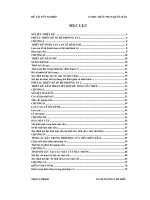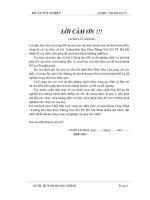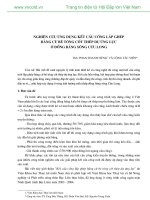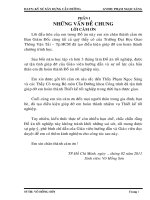các bài báo nghiên cứu chuyên sâu về dầm bê tông cốt thép dự ứng lực có sườn làm bằng tôn lượn sóng ( phần 1)
Bạn đang xem bản rút gọn của tài liệu. Xem và tải ngay bản đầy đủ của tài liệu tại đây (2.14 MB, 10 trang )
A STUDY ON DESIGN METHOD OF SHEAR BUCKLING AND BENDING MOMENT
FOR PRESTRESSED CONCRETE BRIDGES WITH CORRUGATED STEEL WEBS
Hiroyuki Ikeda
Bridge and structural Engineering Division, Chubu Branch, Japan Highway Public Corporation
Aichi, JAPAN
Kenichirou Ashiduka
Bridge and Suructural Engineering Division, Japan Highway Public Corporation
Tokyo, JAPAN
Toshimichi Ichinomiya
Civil Engineering Department, Kajima Technical Research Institute
Tokyo , JAPAN
Yoshihide Okimi
I.T. Solutions Department, Kajima Corporation
Tokyo, JAPAN
Toru Yamamoto
Nagoya Branch, Kajima Corporation
Aichi, JAPAN
Masato Kano
Research and Development Division, Bridge and Computer Engineering Co., Ltd.
Osaka , JAPAN
Keywords: shear buckling, bending moment, strain distribution, finite element analysis
1 INTRODUCTION
Prestressed Concrete box girders with corrugated steel webs were put to practical use in France as
alternatives with lighter weight to conventional prestressed concrete box girders. They have recently
been used in Japan. Shear and flexural behavior of bridges with prestressed concrete girders with
corrugated steel webs has been studied by basic tests and analyses and taken into consideration in
actual design [1].
Shear buckling of corrugated steel webs has been checked using a formula for buckling strength that
is based on Easley's formula and takes the inelastic range into consideration. Prestressed concrete
girders with corrugated steel webs have been applied to medium spans around 80 m, so shear buckling
has not been of predominant concern in design. When the depth of the girder affected by shear
buckling of the web was large, the web exceeding 5 m in depth that is found on the existing bridges has
been lined with concrete to prevent buckling. Effectively treating the cross section of girder that is
expected to increase with the increase of bridge length demands greater accuracy of shear buckling
analysis.
For designing prestressed concrete bridges with corrugated steel webs considering bending
moments and axial forces, only top and bottom concrete slabs of the girder are considered as the cross
sections effective in resisting the forces while ignoring webs, and the Bernoulli's assumption that plane
sections remain plane after bending is loaded. The Bernoulli's assumption is considered applicable
because the strain distribution obtained in loading tests on specimens and actual bridges is close to
285
Composite structures
Session 5
that obtained by calculation based on the assumption. Most of the tests conducted so far involved shear.
It was therefore considered necessary to measure strain distribution using specimens with sufficiently
long sections subject to pure bending to verify the applicability of the Bernoulli's assumption.
In this study, therefore, the applicability of analysis considering both material nonlinearity and
geometric was verified for accurately predicting shear buckling strength. Strain distribution on the top
and bottom concrete slabs was measured using specimens with sections subject to pure bending, and
the validity of the Bernoulli's assumption when bending was predominant was verified.
2 STUDY ON SHEAR BUCKLING
2.1 Specimen
Efforts have been made to accurately predict shear buckling by analysis considering both material
and geometric nonlinearity [2]. Studies have been made in the cases where shear yielding preceded
shear buckling and where buckling occurred in the inelastic range. Specifications of the specimens
used in the past test are shown in Table 1. Buckling strength considering the inelastic range is shown in
Fig. 1. The specimen with a girder depth of 1.2 m and a wave height of 20 mm buckled in the inelastic
range and the one with a wave height of 60 mm buckled after shear yielding occurred. In both cases,
material nonlinearity had a great effect.
For making composite nonlinear analysis to check the shear buckling of corrugated steel webs,
verification of its validity in the range of high geometric nonlinearity is considered necessary. Then, the
applicability of composite nonlinear analysis was examined in the case of buckling in the elastic range,
which was greatly affected by geometric nonlinearity. Buckling in the elastic range could be caused by
reducing the wave height or increasing the girder depth. The girder depth was increased because
reduction of the wave height was likely to cause tests to be affected by fabrication accuracy.
Table 1 Specifications of the specimens used in the past test
Height Thickness Wave length Wave height
(mm) (mm) (mm) (mm)
No.1-1
[2]
20
No.1-2
[2)
30
No.1-3
[2)
60
1200 3.2 400
0.00
0.50
1.00
1.50
0.00 0.50 1.00 1.50 2.00 2.50
Shear buckling param eter λs
Pu/Py
Girder heig h t 1 .2 m
W ave height 60m m
●:E xperiment
△:A nalysis
Grider height 1.2m
W ave height 20m m
Girder height 2.1m
W ave height 20m m
Pu/Py=1/λs2
Yield fa ilu re Ineralsitc b u c k lin g E lastic buckling
Girder heig h t 1 .2 m
W ave height 30m m
Fig.1
Shear buckling strength curve
Proceedings of the 1st fib Congress
286
Analysis was made of the specimens used in the past tests and another specimen of greater girder
depth using various analytical methods (Fig. 2). For the specimen with a girder depth of 1.2 m and a
wave height of 60 mm, the results of composite nonlinear and material nonlinear analyses formed the
same line. The specimen buckled at the range where the load became nearly constant after yielding
occurred. This shows the predominance of material nonlinearity. The specimen with a girder depth of
2.1 m and a wave height of 20 mm, on the other hand, buckled before the effect of material nonlinearity
became apparent, which indicates a predominant influence of geometric nonlinearity. The specimen
with a girder depth of 1.2 m and a wave height of 20 mm buckled after the effect of material nonlinearity
became apparent. Its behavior is at midway between the behavior of the above two specimens.
As a result, in this study, a specimen with a girder depth of 2.1 m, a wave height of 20 mm, a wave
length of 400 mm, a web thickness of 3.2 mm and a span of 4.2 m was tested. Fig. 3 shows the
specimen.
2.2 Test
The specimen was supported on bearings at both ends which allowing free rotation and longitudinal
sliding, and load was applied at midspan by a hydraulic jack (Fig. 4). The load point and supports were
reinforced by ribs with a thickness of 22 mm. In order to prevent the lateral buckling of the specimen,
lateral displacement of the specimen was restrained at top and bottom ends of the supports and at the
0
1000
2000
3000
4000
5000
0102030
Vertical displacement (mm)
Load (kN)
0
500
1000
1500
2000
2500
0 5 10 15
Vertical displacement (mm)
Load (kN)
(a) Girder height 2100mm, wave height 20mm
0
500
1000
1500
2000
2500
0 2.5 5 7.5 10
Vertical displacement (mm)
Load (kN)
Complicated nonlinearity
Material nonlinearity
Geometric nonlinearity
Linear
(b) Girder height 1200mm, wave height
(c) Girder height 1200mm, wave height
Fig.2 Parametric analysis
287
Composite structures
Session 5
load point by roller bearings.
The load and vertical displacement were measured by the load cell and displacement meter,
respectively. Another displacement gauge was placed on the web of the specimen to measure
out-of-plane deformation. The specimen was expected to be affected by its initial shape because it was
designed to buckle in the elastic range, so its initial shape was measured. Initial shape of the specimen
was measured at positions vertically placed at a spacing of 150 mm and at two points each 20 mm
away from the center of the panel of the web that was parallel to the span of the specimen.
2.3 Analysis
For analyzing the shear buckling of corrugated
steel webs, "SLAP" [3], a complicated nonlinear
analysis program, was used. A panel was divided
into four elements horizontally. A nearly square
mesh was formed. The measurements for the
initial shape of the specimen described above
were input as nodal coordinates of the analytical
model.
The results of a material test using test pieces
obtained from the same production lot that
provided the steel plates of the specimen, and
the stress-strain curve for the analytical model
are shown in Fig. 5. The load-displacement curve
was found by prior studies to be greatly affected
by the stress-strain relationship of the steel plate,
so a multi-linear model was used to accurately
reproduce material properties.
2.4 Test and analytical results
Table 2 shows the values of buckling loads
obtained by analysis and test. Fig. 6 shows the
relationship between the load and vertical
displacement. The analytical values deviated
from the test values by 10% or less. Accurate
prediction of shear buckling was verified. The
relationship between the load and vertical
displacement could be analyzed slightly more
accurately when the initial shape was taken into
consideration. The variance was, however, small.
For specimen No. 2-3, loading was continued
20002000
2100
210019 19
4200
180
20
400
10110199 99
3,2
20
400
10110199 99
3,2
20
400
10110199 99
3,2
Fig.3 Dimensions of specimen
F8-1
試験体
Fig.4
Loading method
0
50
100
150
200
250
300
350
0 1000 2000 3000
Strrain (×10-6)
Stress (MPa)
Material test
Analytical model
Fig.5 Stress-strain curve model
Unit (mm)
Proceedings of the 1st fib Congress
288
after buckling. Post-buckling strength was found to be about 80% of the maximum buckling strength.
Fig. 7 shows the relationship between the load and out-of-plane displacement. Fig. 8 shows the
distribution of out-of-plane displacement. According to these figures, it was verified that out-of-plane
deformation that rules buckling can be accurately analyzed by faithfully considering the initial shape of
the specimen.
Fig. 9 is a diagram of out-of-plane deformation obtained by analysis under the maximum load.
Photograph 1 shows buckling encountered during the test. It was known that specimens were subject
to local buckling when they were made inaccurately because they had a small plate thickness. The
specimen used in the test suffered total buckling on one side, which corresponded to the deformation
identified by analysis.
Table 2 Specifications of the specimens and buckling load
With initial
imperfection
Without initial
imperfection
No.1-1
[2]
20 907 894 911
No.1-3
[2]
60 1153 1172 1229
No.2-1 998 1003
No.2-2 941 1020
No.2-3 995 1087
Wave heightHeight Thickness Wave length
20 1085
Dimension of web (mm)
Analysis
Buckling load (kN)
1200
2100
3.2 400
Experiment
(a) Specimen No.2-1
0
200
400
600
800
1000
1200
0.0 2.0 4.0 6.0
Vertical displacement
(
mm
)
Load (kN)
With initial
imperfection
Without initial
imperfection
Experiment
(b) Specimen No.2-3
0
200
400
600
800
1000
1200
0.0 2.0 4.0 6.0 8.0 10.0 12.0
Vertical displacement
(
mm
)
Load (kN)
With initial imperfection
Without initial imperfection
Experiment
Fig.6 Load-vertical displacement relationship
0
200
400
600
800
1000
1200
-20 -10 0 10 20 30
Transverse dispacement (mm)
Load (kN)
With initial
imperfection
Without initial
imperfection
Experiment
0
0.35
0.7
1.05
1.4
1.75
2.1
-5 0 5 10 15
Transverse displacement (mm)
Height of specimen (mm)
With initial
imperfection
Without initial
imperfection
Experiment
Fig.7 Load-lateral displacement relationship Fig.8 Lateral displacement distribution
289
Composite structures
Session 5
3 STUDY ON BENDING MOMENTS AND AXIAL FORCES
3.1 Specimen
The specifications of the specimen and its dimensions are shown Fig. 10. For the corrugated steel
web, a 3.2-mm-thick steel plate was used. The height of the corrugated steel web was set at 1200 mm.
Two variations of wave height, 30 mm and 60 mm, were applied. Concrete slabs with thickness of 250
mm thick and width of 800 mm were combined into the corrugated steel web by angled shear
connectors. The total depth of the girder including the concrete slabs was 1.7 m. The shear span was
set at 3.4 m, double the total girder depth. The length of the pure bending section was set at 5 m, about
three times the girder depth.
Fig.9 Deformation at maximum load (No.2-1) Photo. 1 Specimen after buckling (No.2-1)
Shape of wave Angle shear connector
Fig. 10 Dimensions of specimen
Table 3
Strength of specimen
Event Load (kN)
Cracking of concrete slab 764
Yield of reinforcing bar 2,323
Yield of web plate 1,137
Unit (mm)
Proceedings of the 1st fib Congress
290
The concrete had strength of 40 MPa. Eleven D13 reinforcing bars were placed in either the top or
bottom slab as longitudinal reinforcement. In order to prevent cracking in the initial stages of loading,
one and two prestressing bars of a diameter of 23 mm were placed in the top and bottom slabs, and
prestresses of 152 kN and 583 kN were applied on the top and bottom slabs, respectively. The
compressive stresses applied by prestressing were 0.5 MPa on the top edge of the top slab and 2.8
MPa on the bottom edge of the bottom slab. The shear and flexural strengths of the specimen are listed
in Table 3. The specimen was designed to suffer the shear yielding of the corrugated steel web after
cracking occurred and before the main reinforcement was subjected to flexural yielding.
3.2 Test method
Loads were applied at two points of the specimen simply supported on either end using a 10000-kN
loading machine. Loads were increased monotonously.
Strains were measured at the positions shown in Fig. 11. Strains of the reinforcing bars, corrugated
steel web and steel flanges were measured in three cross sections in the pure bending section
including the midpoint in the specimen, and in another cross section in the shear span. The loads
applied, vertical displacements, out-of-plane displacements and shear displacements in the concrete
slab and corrugated steel web were also measured.
3.3 Analysis
For analyzing the shear buckling of corrugated steel webs, "J-F-C-P" [4], a complicated nonlinear
analysis program, was used. The analysis model is shown in Fig. 12. Only a half of the specimen was
modeled for analysis because the specimen was symmetric. The stress-strain curves used for analysis
are shown in Fig. 13. A bilinear model of the corrugated steel web was made based on material tests.
The part of concrete in tension was represented by a bilinear model to facilitate convergence. The
tensile strength of concrete was set at 0.5 MPa, about one-sixth the actual strength to prevent local
cracking during prestressing.
CL
B
F E D
1700
1700 1200
800
500
Fig. 11 Position of strain gauge
Fig. 12
Analytical model
Support
Center of span
Unit (mm)
291
Composite structures
Session 5
3.4 Test and analytical results
The distribution of strain immediately after prestressing is shown in Fig. 14. The strains in the figure
almost agreed to the strains due to the axial force and eccentric loading that were calculated based on
the Bernoulli’s assumption.
Fig. 15 shows the relationships between the load and vertical displacement. Although the tensile
strength of concrete was estimated low in the analysis, cracking load and rigidity after cracking were
almost the same comparing the test results and analysis.
0
100
200
300
400
500
0 2000 4000 6000 8000 10000
Strain
(
µ
)
Stress
(
MPa
)
Test
Analysis
-10
0
10
20
30
40
50
-0.5 0.0 0.5 1.0 1.5
応力 (MPa)
ひずみ (%)
(a) Web plate (b) Concrete
Fig. 13 Analytical model of stress-strain curves
Strain (%)
Stress
(
MPa
)
0
250
500
750
1000
1250
1500
1750
-150 -100 -50 0 50
Strain (µ)
Height (mm)
Wave height 30mm
Wave height 60mm
Bernoulli's theorem
系
Fig. 14
Strain distribution for prestressing
0
200
400
600
800
1000
1200
1400
1600
0 20406080
Vertical displacement (mm)
Load (kN)
Test
Analysis
0
200
400
600
800
1000
1200
1400
1600
1800
0 20406080100
Vertical displacement (mm)
Load (kN)
Test
Analysis
Fig. 15 Load-vertical displacement relationship
Proceedings of the 1st fib Congress
292
In the specimen with a wave height of 30 mm, experiencing shear buckling and shear yielding almost
simultaneously (Fig. 1), shear buckling occurred immediately following shear yielding and the load
decreased rapidly. In the specimen with a wave height of 60 mm, suffering shear yielding before shear
buckling (Fig. 1), the rate of increase in load decreased after shear yielding and the load started
gradually decreasing. Then, shear buckling caused the load to decrease rapidly.
Continued loading after shear buckling created a tension field in the specimen with a wave height of
30 mm and caused the load to increase gradually. The axial reinforcing bars yielded before the load
was applied which induced shear buckling, decreasing the load, and deformation started to vary at the
two load points. Then, loading was discontinued. In the specimen with a wave height of 60 mm,
displacement increased before a tension field was created, and the concrete of the top slab suffered
compressive failure between the load points.
Fig. 16 shows the strain distribution for the specimen with a wave height of 30 mm at a load of 500
kN, the load before cracking occurred. The figure also shows the strain distribution obtained by
three-dimensional finite element analysis and that obtained based on the Bernoulli’s assumption and
assuming that the full cross section was effective in resisting forces. In cross sections E and F in the
pure bending section, the strain distribution obtained based on the Bernoulli's assumption almost
agreed to the test result for concrete slabs. The Bernoulli's assumption was evidently effective. In cross
section D, although it is in the pure bending section, the Bernoulli's assumption was not true owing to
the influence of concentrated loading. In cross section B in the shear span, the strain distribution
identified by the analysis deviated slightly from the distribution obtained based on the Bernoulli's
assumption because of the influence of shearing force, but the variance was small. In all cross sections,
the results of the test and the three-dimensional finite element analysis almost agreed to each other. It
Section B
0
250
500
750
1000
1250
1500
1750
-15
0
-10
0
-50 0 50 100 150
Strain (µ)
Height
(
mm
)
Section D
0
250
500
750
1000
1250
1500
1750
-15
0
-10
0
-50 0 50 100 150
Strain (µ)
Height
(
mm
)
Test
FEM
Bernoulli's
theorem
Section E
0
250
500
750
1000
1250
1500
1750
-150 -100 -50 0 50 100 150
Strain (µ)
Height (mm)
Section F
0
250
500
750
1000
1250
1500
1750
-15
0
-10
0
-50 0 50 100 150
Strain (µ)
Height
(
mm
)
Test
FEM
Bernoulli's
theorem
Fig. 16 Strain distribution at load of 50kN
293
Composite structures
Session 5
was therefore verified that the analysis could accurately predict the strains of corrugated steel plate and
concrete not only in the case where the Bernoulli's assumption was true but also in the sections under
the influence of concentrated loads. Similar results were also obtained for the specimen with a wave
height of 60 mm.
4 CONCLUSIONS
The test and analysis made in this study produced the following results.
(1) It was verified that shear buckling strength and the relationship between load and deformation could
be analyzed accurately even in the range under a great influence of geometric nonlinearity. Thus, the
validity of the analysis method was verified.
(2) It was revealed that the analysis considering the initial shape of the specimen could analyze the
relationship between load and vertical displacement and the relationship between load and
out-of-plane deformation more accurately than the analysis without such considerations.
(3) As a result of a flexural load test on specimens with concrete slabs, it was found that the Bernoulli's
assumption was true in the elastic range in the pure bending section.
(4) In cross sections near the position where loads were concentrated, the Bernoulli's assumption did
not hold true even in the pure bending section. The analysis, however, could predict the test results
accurately.
ACKNOWLEDGEMENTS
The authors would like to thank the members in the technical committee of the long span composite
bridges with corrugated steel webs (the chairman: Prof. E. Watanabe, Kyoto University) for their helpful
suggestions and comments. They also would like to acknowledge the assistance of Mr. J. Okada (NKK
Corporation) for accomplishment of the experimental program.
REFERENCES
[1] Research Group of Composite Structure with Corrugated Steel Web : Design Manual of PC Box
girders with corrugated steel webs. Dec., 1998 (in Japanese)
[2] Watanabe, E., Kadotani, T., Miyauchi, M., Tomimoto, M. and Kano, M. : Shear Buckling of
Corrugated Steel Web. The First International Conference on Structural Stability and Dynamics
Dec., 2000
[3] Okimi, Y. and Ukon, H. : A Frame Analysis System with Geometrical and Material Nonlinear
Properties. Journal of the Japan Society of Civil Engineers, Vol. 80, Jan., 1995 (in Japanese)
[4] Kano, M., T. Yamano, M. Nibu, and T. : A Computer Program, USSP, for Analyzing Ultimate
Strength of Steel Plated Structures. Proceedings of the 5th International Colloquium on Stability
and Ductility of Steel Structures, Jul., 1997
Proceedings of the 1st fib Congress
294









